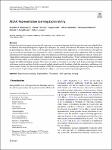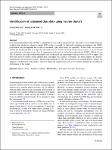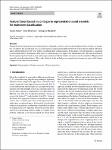Search
Author
- Jorgensen, Ed (3)
- McFadyen, Ron (3)
- Nora, El-Rashidy (3)
- Christian, Homeyer (2)
- next >
Subject
- programming (10)
- Open Access (8)
- Java (7)
- Programming (7)
- next >
Date issued
- 2020 - 2025 (293)
- 2010 - 2019 (39)
- 2000 - 2009 (2)
- 1999 - 1999 (1)
Has File(s)
- true (335)
Search Results
The study of natural and human-made processes often results in long sequences of temporally-ordered values, aka time series (TS). Such processes often consist of multiple states, e.g. operating modes of a machine, such that state changes in the observed processes result in changes in the distribution of shape of the measured values. Time series segmentation (TSS) tries to find such changes in TS post-hoc to deduce changes in the data-generating process. TSS is typically approached as an unsupervised learning problem aiming at the identification of segments distinguishable by some statistical property. Current algorithms for TSS require domain-dependent hyper-parameters to be set by the user, make assumptions about the TS value distribution or the types of detectable changes which li... |
Despite the significant improvements that self-supervised representation learning has led to when learning from unlabeled data, no methods have been developed that explain what influences the learned representation. We address this need through our proposed approach, RELAX, which is the first approach for attribution-based explanations of representations. Our approach can also model the uncertainty in its explanations, which is essential to produce trustworthy explanations. RELAX explains representations by measuring similarities in the representation space between an input and masked out versions of itself, providing intuitive explanations that significantly outperform the gradient-based baselines. |
The risk-based access control model is one of the dynamic models that use the security risk as a criterion to decide the access decision for each access request. This model permits or denies access requests dynamically based on the estimated risk value. The essential stage of implementing this model is the risk estimation process. This process is based on estimating the possibility of information leakage and the value of that information. Several researchers utilized different methods for risk estimation but most of these methods were based on qualitative measures, which cannot suit the access control context that needs numeric and precise risk values to decide either granting or denying access. Therefore, this paper presents a novel Adaptive Neuro-Fuzzy Inference System (ANFIS) mod... |
Nearest neighbour similarity measures are widely used in many time series data analysis applications. They compute a measure of similarity between two time series. Most applications require tuning of these measures’ meta-parameters in order to achieve good performance. However, most measures have at least O(L2)
complexity, making them computationally expensive and the process of learning their meta-parameters burdensome, requiring days even for datasets containing only a few thousand series. In this paper, we propose ULTRAFASTMPSEARCH, a family of algorithms to learn the meta-parameters for different types of time series distance measures. These algorithms are significantly faster than the prior state of the art. Our algorithms build upon the state of the art, exploiting the prope... |
Convolutional neural networks (CNNs), a representative type of deep neural networks, are used in various fields. There are problems that should be solved to operate CNN in the real-world. In real-world operating environments, the CNN’s performance may be degraded due to data of untrained types, which limits its operability. In this study, we propose a method for identifying data of a type that the model has not trained on based on the neuron cluster, a set of neurons activated based on the type of input data. In experiments performed on the ResNet model with the MNIST, CIFAR-10, and STL-10 datasets, the proposed method identifies data of untrained and trained types with an accuracy of 85% or higher. The more data used for neuron cluster identification, the higher the accuracy; conve... |
Feature-level-based fusion has attracted much interest. Generally, a dataset can be created in different views, features, or modalities. To improve the classification rate, local information is shared among different views by various fusion methods. However, almost all the methods use the views without considering their common aspects. In this paper, wavelet transform is considered to extract high and low frequencies of the views as common aspects to improve the classification rate. The fusion method for the decomposed parts is based on joint sparse representation in which a number of scenarios can be considered. The presented approach is tested on three datasets. The results obtained by this method prove competitive performance in terms of the datasets compared to the state-of-the-... |
This paper introduces a set of numerical methods for Riemannian shape analysis of 3D surfaces within the setting of invariant (elastic) second-order Sobolev metrics. More specifically, we address the computation of geodesics and geodesic distances between parametrized or unparametrized immersed surfaces represented as 3D meshes. Building on this, we develop tools for the statistical shape analysis of sets of surfaces, including methods for estimating Karcher means and performing tangent PCA on shape populations, and for computing parallel transport along paths of surfaces. Our proposed approach fundamentally relies on a relaxed variational formulation for the geodesic matching problem via the use of varifold fidelity terms, which enable us to enforce reparametrization independence w... |
Vibration measurement and monitoring are essential in a wide variety of applications. Vibration measurements are critical for diagnosing industrial machinery malfunctions because they provide information about the condition of the rotating equipment. Vibration analysis is considered the most effective method for predictive maintenance because it is used to troubleshoot instantaneous faults as well as periodic maintenance. Numerous studies conducted in this vein have been published in a variety of outlets. This review documents data-driven and recently published deep learning techniques for vibration-based condition monitoring. Numerous studies were obtained from two reputable indexing databases, Web of Science and Scopus. Following a thorough review, 59 studies were selected for syn... |
In the last decade, a large number of knowledge graph (KG) completion approaches were proposed. Albeit effective, these efforts are disjoint, and their collective strengths and weaknesses in effective KG completion have not been studied in the literature. We extend PLUMBER, a framework that brings together the research community’s disjoint efforts on KG completion. We include more components into the architecture of PLUMBER to comprise 40 reusable components for various KG completion subtasks, such as coreference resolution, entity linking, and relation extraction. Using these components, PLUMBER dynamically generates suitable knowledge extraction pipelines and offers overall 432 distinct pipelines. We study the optimization problem of choosing optimal pipelines based on input sent... |
We investigate the queue number of posets in terms of their width, that is, the maximum number of pairwise incomparable elements. A long-standing conjecture of Heath and Pemmaraju asserts that every poset of width w has queue number at most w. The conjecture has been confirmed for posets of width w=2 via so-called lazy linear extension. We extend and thoroughly analyze lazy linear extensions for posets of width w>2. Our analysis implies an upper bound of (w−1)2+1 on the queue number of width-w posets, which is tight for the strategy and yields an improvement over the previously best-known bound. Further, we provide an example of a poset that requires at least w+1 queues in every linear extension, thereby disproving the conjecture for posets of width w>2
. |










